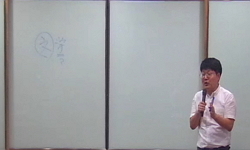Tale 〈Tiger’s Eyebrows〉 and Drama 〈I Hear Your Voice〉 are the works based on a similar motif of seeing human beings inner worlds or hearing human beings think in their minds. The purpose of this research thesis is to make a comparative revie...
http://chineseinput.net/에서 pinyin(병음)방식으로 중국어를 변환할 수 있습니다.
변환된 중국어를 복사하여 사용하시면 됩니다.
- 中文 을 입력하시려면 zhongwen을 입력하시고 space를누르시면됩니다.
- 北京 을 입력하시려면 beijing을 입력하시고 space를 누르시면 됩니다.
https://www.riss.kr/link?id=A100561634
- 저자
- 발행기관
- 학술지명
- 권호사항
-
발행연도
2015
-
작성언어
Korean
-
주제어
< ; 호랑이 눈썹> ; < ; 너의 목소리가 들려> ; 환유 ; 은유 ; 모티프 ; 〈Tiger’s Eyebrows〉 ; 〈I Hear Your Voice〉 ; Metonymy ; Metaphor ; Motif
-
KDC
810
-
등재정보
KCI우수등재
-
자료형태
학술저널
- 발행기관 URL
-
수록면
259-288(30쪽)
- DOI식별코드
- 제공처
- 소장기관
-
0
상세조회 -
0
다운로드
부가정보
다국어 초록 (Multilingual Abstract)
Firstly, the main motifs of this tale are mysterious competence of tigers eyebrow, switching for spouse, and a poor man becoming rich. These motifs can be interpreted as metonymy of desires to look through human beings nature, contemporary peoples marriage life and ordinary peoples poor life. On the great chain metaphor levels, fable can be interpreted as metaphor of the reversal of life impossible to materialize in real life.
The main motifs of this drama are supernatural powers to read peoples mind, every unchanged heart of a male central character and vengeance representing eye for eye and mouth for mouth, etc. These motifs can be understood as metonymy expressions : truth and falsity, contemporary peoples love and marriage and the maintenance of social orders by accomplishing legalism. On the great chain metaphor levels, drama can be also regarded as metaphor which implies a general feature contemporary people watch TV drama.
Seeing from the interpretation of metonymy on the basis of temporal and spatial affinity, the two narratives imply a lot of common features. One of the starkest features is that they absorb in contemporary peoples individual situations to evoke up peoples sympathy or indefinitely assume the metonymy of desires for the reality.
Deducing the general features which these two narratives metaphorize on the levels of great chain metaphor, it can be seen that the two narratives are very close. This fable expresses a desire to change the reality based on fantasy and topple up the system. However at last, it just remains as a substitute satisfaction by developing a narrative. This drama underlies the supremacy for the system and the advocacy for a system. Viewers might reversely have some doubt or a sense of unstability for the absence of elements and subject-matter which can upset the reality, say, can relieve off the sense of anxiety for the reality in drama.
Tale 〈Tiger’s Eyebrows〉 and Drama 〈I Hear Your Voice〉 are the works based on a similar motif of seeing human beings inner worlds or hearing human beings think in their minds. The purpose of this research thesis is to make a comparative review on the two narratives by examining metonymy and metaphor appearing in the main motifs of tales and dramas and analyzing the meanings of them.
Firstly, the main motifs of this tale are mysterious competence of tigers eyebrow, switching for spouse, and a poor man becoming rich. These motifs can be interpreted as metonymy of desires to look through human beings nature, contemporary peoples marriage life and ordinary peoples poor life. On the great chain metaphor levels, fable can be interpreted as metaphor of the reversal of life impossible to materialize in real life.
The main motifs of this drama are supernatural powers to read peoples mind, every unchanged heart of a male central character and vengeance representing eye for eye and mouth for mouth, etc. These motifs can be understood as metonymy expressions : truth and falsity, contemporary peoples love and marriage and the maintenance of social orders by accomplishing legalism. On the great chain metaphor levels, drama can be also regarded as metaphor which implies a general feature contemporary people watch TV drama.
Seeing from the interpretation of metonymy on the basis of temporal and spatial affinity, the two narratives imply a lot of common features. One of the starkest features is that they absorb in contemporary peoples individual situations to evoke up peoples sympathy or indefinitely assume the metonymy of desires for the reality.
Deducing the general features which these two narratives metaphorize on the levels of great chain metaphor, it can be seen that the two narratives are very close. This fable expresses a desire to change the reality based on fantasy and topple up the system. However at last, it just remains as a substitute satisfaction by developing a narrative. This drama underlies the supremacy for the system and the advocacy for a system. Viewers might reversely have some doubt or a sense of unstability for the absence of elements and subject-matter which can upset the reality, say, can relieve off the sense of anxiety for the reality in drama.
동일학술지(권/호) 다른 논문
-
- 국어국문학회
- 李燦揆(Lee, Chan-kyu)
- 2015
- KCI우수등재
-
외국인 학습자와 한국인 화자의 질의응답 양상 분석 연구
- 국어국문학회
- 서진숙(Seo, Jin-suk)
- 2015
- KCI우수등재
-
충무공 이순신가의 문중 교육과 <나부가>류 가사 작품들
- 국어국문학회
- 구사회(Gu, Sa-whae)
- 2015
- KCI우수등재
-
言語 慣習과 文學的 慣習이 韻律 層位 形成에 미친 影響에 대한 硏究
- 국어국문학회
- 박경우(Park, Kyung Woo)
- 2015
- KCI우수등재





 DBpia
DBpia







